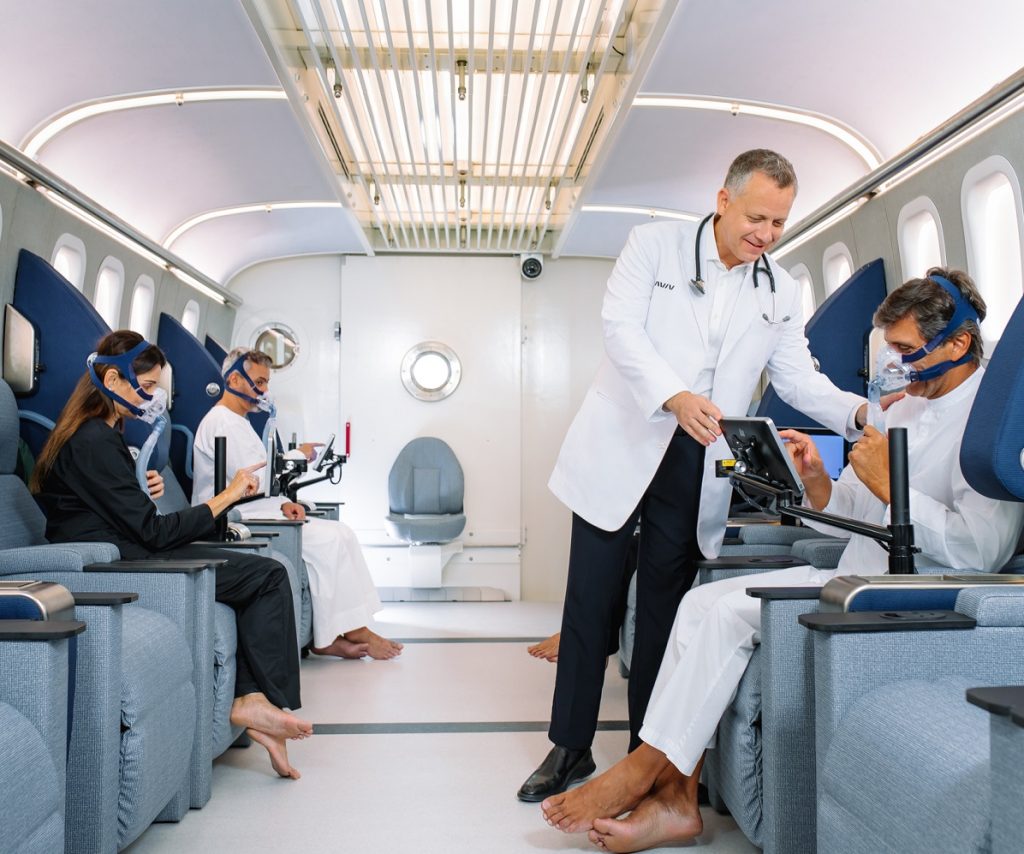Hyperbaric Oxygen Therapy’s Impact on Stroke Treatment
You deserve to achieve your goals and live a happy and fulfilling life. But when a stroke happens and your life changes, your plans do too… the road to post-stroke recovery can feel impossibly hard.
Rest assured that all is not lost. Aviv Clinics, brought to you by DP World, uses advanced tools and therapies for stroke rehabilitation and research-backed processes that unlock your mind and body’s natural self-healing mechanisms.
Learn all about Aviv’s Medical Program which includes hyperbaric oxygen therapy for stroke patients, so you can regain physical vibrancy and emotional well-being.
“There’s a growing body of medical research that shows hyperbaric medicine can help with the rehabilitation of people suffering from stroke.” – Dr. Zemer Wang, Medical Director of Aviv Clinics.
What Is Hyperbaric Oxygen Therapy?
In hyperbaric oxygen therapy (HBOT), patients breathe 100% pure medical-grade oxygen in a pressurized chamber. Paired with oxygen fluctuations, this process boosts oxygen levels in the body up to 10 times higher than normal and helps unlock the body’s self-healing capabilities.
Who Can Try HBOT for Stroke Relief?
Don’t let the idea that the brain has a limited window for improvement stop you from getting the help you need. Stroke survivors at any stage in their recovery can seek treatment with HBOT and other complementary therapies.
While many HBOT studies were conducted on people who had their stroke incident within a three-year timeframe, Dr. Efrati has seen similar improvement in patients whose brain injuries occurred up to 20 years before.
Please understand that not everyone is a candidate for the Aviv Medical Program. Our rigorous assessment process ensures we select the clients who can benefit from the program. Speak with an Aviv Clinics team member to learn if you’re a candidate for our program.
How Does Aviv’s Unique HBOT Protocol for Stroke Work?
When a stroke occurs, some brain tissue dies while other tissue is damaged. HBOT can help trigger the body to self-repair the damaged brain tissue and improve cognitive function after a stroke.
As part of the Aviv Medical Program, we follow a unique, highly specialized HBOT protocol for stroke that differs from other types of oxygen therapy. We focus on providing a personalized care program aligned with your needs and goals.
Here’s how our process works:
- Aviv uses multiplace oxygen chambers—large treatment suites fitting up to 14 people—rather than small, confining, one-person HBOT chambers.
- Clients breathe 100% pure oxygen through a mask in a pressurized environment. This process increases the blood oxygen concentration to help deliver oxygen to the cells that need it.
- Patients follow a specific Aviv protocol where they breathe 100% oxygen with frequent breaks to breathe normal air, which the body then perceives as the trigger for self regeneration. This repeated fluctuation triggers the body into cell repair and regeneration mode.
Cindy Parsons Finds Hope 4 Years After Her Stroke Incident
For Cindy, simple capabilities like combing her hair, driving, and walking unassisted were suddenly stripped away by a stroke. She had been told not to expect more improvement after six months of recovery. Cindy sought the help of Aviv Clinics, and during her assessment, brain scans indicated brain tissue could still be revived.
Watch Cindy’s remarkable stroke recovery story:
Cindy’s personalized Aviv Medical Program included:
- 60 daily HBOT sessions
- Cognitive training
- Physical, occupational, and speech therapy
- Strength training
- A specialized diet plan
Upon the conclusion of the treatment plan, Cindy can now drive herself, walk without a cane, and talk clearly—activities she thought she would never be able to do again.
Cindy’s post-treatment clinical results show numerous improvements in the following ways:
- Skeletal muscle mass increased.
- Muscular strength improved.
- Fall risk dropped.
- Gait speed and quality improved.
- Nonverbal memory increased.
- Information processing speed climbed.
- Motor planning improved.
“It didn’t take long at Aviv before I was able to get the courage to try things. And now that fear is 95% gone.” Cindy Parsons, stroke survivor and former Aviv Clinics client.
Hyperbaric Oxygen Therapy for Stroke Patients: Clear, Proven Research
Recent clinical studies at The Sagol Center for Hyperbaric Medicine and Research have evaluated the effects of hyperbaric oxygen therapy for stroke patients.
The center’s studies show the powerful potential of HBOT as it:
- Triggers neuroplasticity—when healthy parts of the brain “rewire” to assist injured parts of the brain.
- Encourages neurogenesis—the creation of new nerve cells.
- Creates new blood vessels for higher blood flow and oxygenation of tissue.
- Increases neurocognitive abilities in post-stroke patients.
An Evidence-Based Treatment Protocol
Numerous studies continue to show the unique HBOT protocol—available only at Aviv Clinics—makes significant stroke-recovery improvements in people even years after the stroke event.
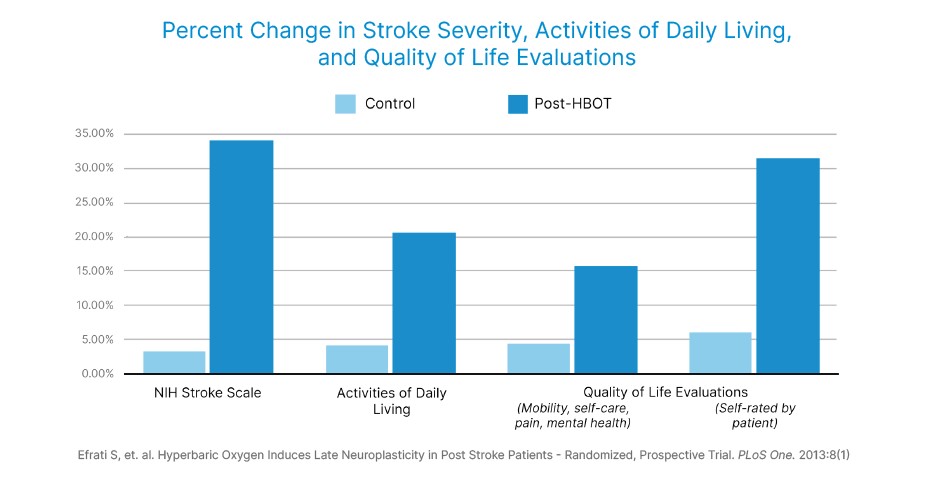
Well let these research findings and case studies speak for themselves:
- “The results indicate that HBOT can lead to significant neurological improvements in post stroke patients even at chronic late stages.” –Dr. Shai Efrati, Founder and Director of The Sagol Center
- “The results illustrate the potential of [HBOT] for improving memory impairments in post-stroke patients, even years after the acute event.” – Dr. Shai Efrati
Watch Keren’s Recovery Story
Upon suffering a stroke, businesswoman and mother Keren Trabelsi sought the help of Aviv. Learn what her program was like and how her brain and body benefited from her personalized health program.
“[The Aviv Medical Program] brings back your ego, it brings back your self-esteem…it changed my life.”
How Can the Aviv Medical Program Help with Stroke Relief?
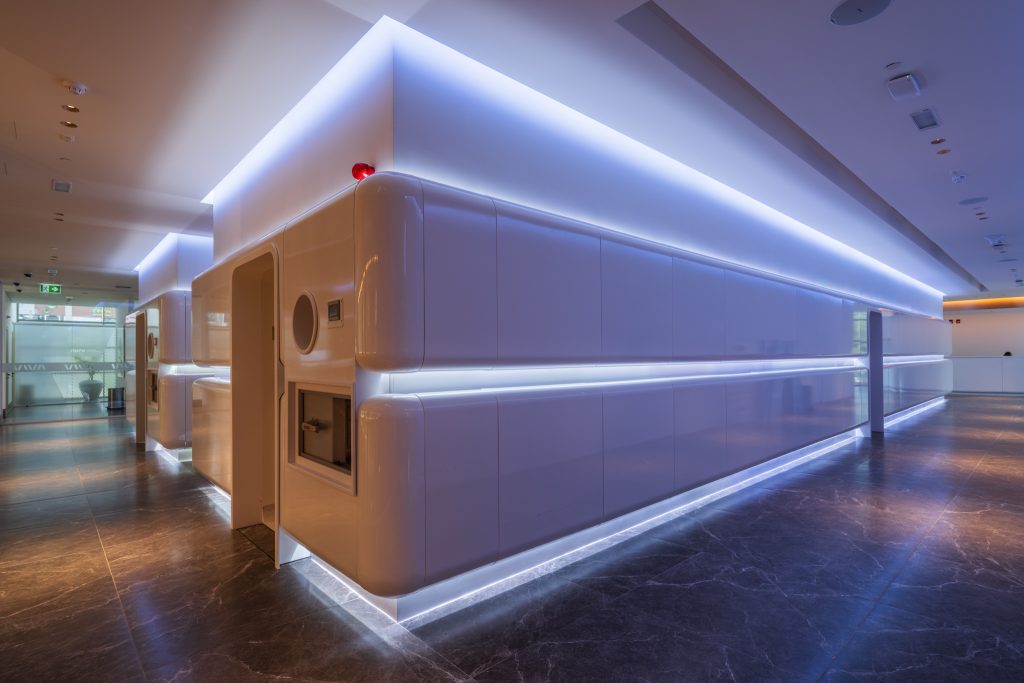
Our program is founded on Dr. Efrati’s research. Regaining functions and abilities more than six months post stroke requires working with a diverse medical team of physicians, nurses, and therapists. Aviv Clinics maximizes the expertise of this comprehensive team to offer a high-quality program that meets your needs.
The Aviv Medical Program can combine the following elements in a customized program to help treat the body and brain after a stroke:
- Hyperbaric oxygen therapy
- Cognitive training
- Physical training and therapy
- Dietary coaching
How It Works: A 3-Step Process
Aviv Clinics’ approach entails a three-step process:
- In-depth Medical Assessment: Our assessment process identifies how much of your brain tissue died from the stroke and how much of it is merely injured—these are areas we want to focus on to help regain your capabilities. We use the most advanced brain imaging tests (e.g., MRI and SPECT) suited to your needs. The Aviv team also conducts physical, cognitive, and neurological tests to evaluate your function in these areas and establish a baseline.
- Tailored Program: We use your results to develop a personalized therapy plan. This plan can include cognitive and physical training, dietary coaching, and HBOT sessions. A dedicated medical team will walk you through your therapy plan to maximize your body’s healing process.
- Post-assessment and Evaluation – Measurable Results: After your Aviv Medical Program treatments, you’ll receive a detailed report of your results, including any cognitive and physical changes. We repeat the tests from the initial assessment to measure your improvement and make recommendations for ongoing progress.
What Benefits Can Stroke Survivors Achieve with HBOT?
When combined with personalized cognitive, physical, and nutritional therapies, HBOT as a part of your stroke regimen may produce impressive outcomes, even years after a stroke, including the following results:
- Improved speech and ability to read/write
- Restored motor function, even with paresis
- Return to independence in performing many daily activities
Many of our clients report the most significant benefit is simply not being “a burden” on their loved ones.
Here’s how our program can impact the brain, body, and cells even years after a stroke.
Benefits for your brain*:
- Rehabilitation of injured brain tissue, restoring some impacted functions
- Increased blood flow in the parts of the brain that may have reduced blood flow due to the stroke
- New stem cells and blood vessels in the brain (angiogenesis)
- Improved psychomotor function (the combination of precise motor responses and cognitive problem-solving abilities)
- Triggered neuroplasticity (the brain’s ability to adapt/react in response to injury or disease) in injured parts of the brain
- Triggered neurogenesis (neuronal or nerve cell) regeneration that occurs in the brain.
- Improved overall quality of life
Benefits for your body*:
- Better physical performance: mobility, fitness, strength, coordination, balance, gait
- Improved NIHSS (neurological motor function score), ADL (activities of daily living score), and EQ-5D (quality of life score)
- Boosted power and stamina
- Reduced pain (strong anti-inflammatory effect)
- Improved sleep quality
Benefits for your cells*:
- Strengthened immune system
- Increase in stem cells (the building blocks of tissue rejuvenation) to multiply and migrate
- Quantitative and qualitative improvement in mitochondrial biogenesis (the power center of the cell)
*Individual patient results may vary.
“A 64-year-old woman suffered from left hemiparesis—or weakness in the left side of the body—due to ischemic stroke. She had the stroke two years before coming to our program. We significantly improved the blood flow throughout the brain. This person actually had improvement in their left-sided stroke symptoms two years after the stroke.” –Dr. Mohammad Elamir, MD, FACP
Speak with an Aviv Clinics team member to learn if you’re a candidate for our program.
Hyperbaric Oxygen Therapy (HBOT) Options for Stroke Recovery
Stroke Recovery
Stroke prevalence has spurred scientists to develop more effective stroke recovery therapies, including hyperbaric oxygen therapy (HBOT).
Recovery from an ischemic or TIA (“mini stroke”) may not be guaranteed, but this much is clear: people who receive timely and effective treatment recover with fewer post-stroke effects.
Unfortunately, timely treatment is not always attainable:
- Stroke is a “leading cause of death in the United States and is a major cause of serious disability for adults.”
- “More than half of stroke survivors age 65 and older” experience reduced mobility, relegating some individuals to a wheelchair for the remainder of their lives. Many struggle with cognitive function, speech difficulties, and visual impairments as well.
Thankfully, advanced rehabilitation programs exist, including hyperbaric oxygen therapy (HBOT) options and other therapies. The experts at Aviv Clinics discuss these key details below.
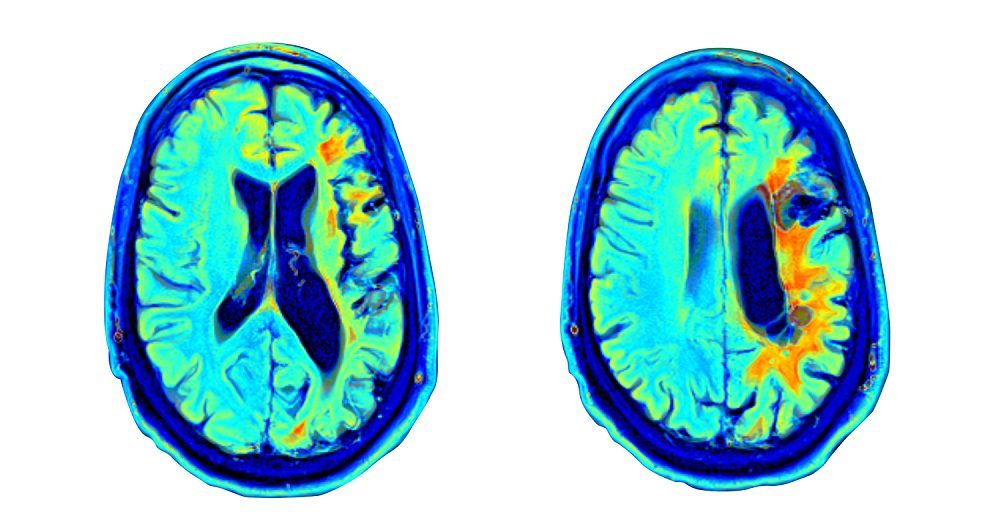
What Happens to the Brain during a Stroke?
When a stroke strikes, it immediately starts killing brain cells due to loss of blood flow. As many as two million brain cells die each minute the stroke goes untreated. Other cells become injured but don’t necessarily die off. Neurologists often describe them as being “stunned”.
Still, a significant part of the brain’s real estate comes under attack. The combined damage from injured and necrotic (dead) brain cells results in both immediate and long-term symptoms such as:
- Limb weakness or paralysis
- Slurred speech
- Vision complications
- Balance issues.
Nothing can be done about the dead brain cells, which is why timely intervention is so critical. However, a growing body of research indicates that HBOT can help repair the injured cells, even years after the initial stroke
What Is Hyperbaric Oxygen Therapy (HBOT)?
Hyperbaric oxygen therapy (HBOT) is a type of therapy that uses pressurized chambers to allow individuals to breathe in 100% pure oxygen.
In the hyperbaric suites at Aviv Clinics, the air is pressurized in the HBOT chamber to above atmospheric levels. This environment increases oxygen levels in the body to about 17 times higher than normal, allowing oxygen to be delivered even to damaged cells, such as those injured by stroke.
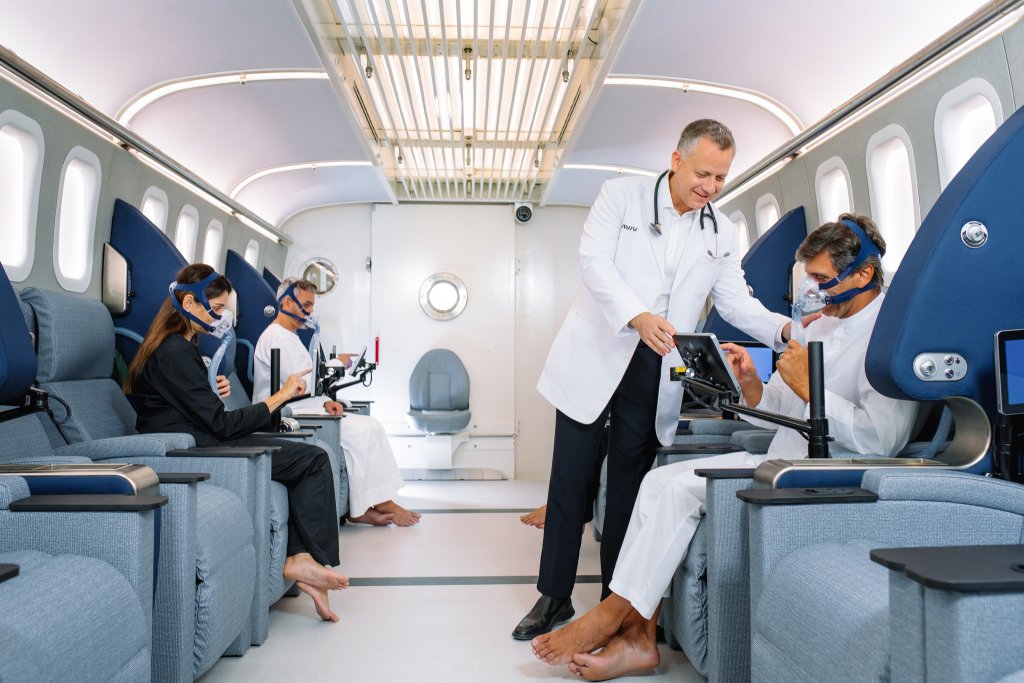
How Does HBOT Help with the Post-Stroke Recovery Process?
The unique HBOT protocol at Aviv Clinics uses a scientifically validated process in which oxygen levels are fluctuated throughout the HBOT session. When the mask is on, oxygen levels are very high. But, when the mask is off, the body is deceived into sensing a state of “low” oxygen because of the rapid decline.
This fluctuation triggers the body into repair and regeneration mode, which in turn:
- Stimulates stem cell proliferation
- Improves injured cell health
- Builds new blood vessels, optimizing blood flow
- Grows new connections in the brain
In the past, growing those new connections was inconceivable. Scientists previously believed that once neurons were destroyed, they could never rebound. Research has since disproved that notion.
What Benefits Can Stroke Survivors Achieve with HBOT?
Several studies have proven the benefits of using HBOT in post-stroke recovery. Repair mechanisms in the brain, prompted by HBOT, result in:
- Regained speech and reading capabilities
- Restored motor function, even with paresis
- Return to independence in performing daily activities
The Aviv Medical Program
When combined with the exercise, personalized nutrition, and extensive assessments that are part of the Aviv Medical Program, the outcomes become even more impressive:
- Some Aviv clients progress from using wheelchairs to walking on their own or with an assistive device.
- Clients who lost their ability to speak make immense recovery strides.
- Many report that the biggest benefit is simply not being a “burden” on their loved ones.
Our post-stroke program remains focused on research and incorporates a holistic and personalized approach that can include the following:
- In-depth review of health history
- Comprehensive physical exam
- Highly advanced brain imaging scans
- Neurological and neurocognitive tests
- Body composition analysis
- A detailed report of our assessment findings
- Cognitive training
- Physical training
- Dietary coaching
- Hyperbaric oxygen therapy (HBOT)
- A post-treatment report of your improvements and recommendations for future progress
Learn more about the program>>
Even if a person has no visible effects after having a stroke, the brain has still been damaged—and they are at a higher risk for a subsequent stroke. HBOT, through the Aviv Medical Program, can help mitigate that risk by improving the flow of blood to brain tissue and potentially prevent future strokes from occurring.
How Soon after a Stroke Can Hyperbaric Oxygen Therapy Be Administered?
Aviv Clinics recommends a 3-6 month wait after a stroke before beginning the Aviv Medical Program protocols. This allows for the brain’s natural healing progression to take hold.
The sooner stroke survivors act after the post-acute stage, the better. The research our scientists have done indicates a strong cohort from the one-month point to four years post-stroke.
That said, there’s really no limit on how long after a stroke individuals can participate in the program. We’ve seen success in clients who were as many as 10 years into their stroke recovery.
How Long Does It Take to See Results?
Most people see improvement from the Aviv Medical Program within the 8-12 weeks of therapy and medically verifiable results by the end of their treatment.
But keep in mind, no one-size-fits-all approach exists. You’ll receive your own unique therapy plan, so outcomes and timelines vary. Our ability to quantify your health plan is ultimately what delivers results.
For reference, here is a general overview of what our program looks like:
- Step 1: Assessment—A comprehensive set of neurocognitive, physical, and genomic assessments.
- Step 2: Treatment—Based on the assessment, we develop a customized routine that can include hyperbaric oxygen sessions with other types of personalized training/therapies. These may take place over 12 weeks.
- Step 3: Analysis—Our team uses advanced analytics to assess your program’s efficacy, and make the necessary adjustments.
- Step 4: Follow up—The Aviv Clinics team will offer ongoing monitoring and engagement post-treatment to help maintain your results.
Keren Trabelsi Finds Hope after Her Stroke
“[Treatment at Aviv is] like driving a Ferrari on the road to recovery versus driving like an old beaten-up car….”
Former Aviv Clinics client Keren underwent an ischemic stroke. This caused cognitive issues and paralysis on the left side of her body. Daily tasks grew more difficult, which left her feeling defeated.
Fortunately, Keren found the Aviv Medical Program. Aviv Clinics provided a personalized treatment plan encompassing many of the therapies we outlined earlier.
Thirteen months later, Keren can walk comfortably, type with her left hand again, and engage in a myriad of activities (crossword puzzles, Sudoku, etc.) she couldn’t participate in after her stroke.
The Bottom Line
Stroke survivors no longer need to feel like life is over due to debilitating cognitive and physical impairments. The Aviv Medical Program is rooted in extensive scientific research and has been instrumental in helping stroke survivors thrive well into their golden years.
Contact us to learn more about the Aviv Medical Program and how it can benefit you or a loved one.
Schedule a free consultation>>
Rehabilitation Options, Including Hyperbaric Oxygen Therapy (HBOT), for Stroke Patients
Strokes are “a leading cause of serious long-term disability” in the United States. Given that “87% of all strokes are ischemic” or caused by artery or vein blockage, it makes sense that most patients suffer long-term functional impairments.
These impairments can range from paralysis, speech difficulties, and sensory issues to a host of other cognitive dysfunctions. Additionally, many stroke patients have had a stroke before—“nearly 1 in 4” survivors have suffered at least one stroke previously.
Rest assured, multiple rehabilitation options are available for stroke patients, including hyperbaric oxygen therapy (HBOT). We dive into the key details below.
Remember that each person’s medical condition and background are entirely unique. Thus, speaking with a physician about treatment options is essential to getting back to optimal health.

What Are the 3 Common Stroke Relief Options?
Stroke relief generally entails working with a diverse medical team of physicians, nurses, and therapists. This support team may recommend one or more of the following options:
- Speech therapy: Stroke patients can experience speech challenges, ranging from slurred world to significant difficulties with oral communication or understanding people (aphasia). This is due to damage to the “left side of the brain that controls speech and language.” Cases like this often merit speech therapy.
Patients work with speech-language pathologists (SLPs) to relearn techniques such as:
- Controlling mouth and throat muscles to speak more clearly and adequately swallow
- Participating in cognitive language exercises to restore communication and comprehension skills
Research illustrates early speech intervention with aphasia patients “had a massive increase in their ability to communicate at 12 and 26 weeks after their stroke.” Patients could speak better and exhibited less difficulty finding and using the right words.
- Physical therapy: A physical therapist (PT) engages patients in movement exercises to help them reacquire motor skills. PTs generally help stroke patients relearn activities such as walking, sitting, standing, and switching from one movement to another.
Medical experts believe consistent PT lowers “risks of hospital readmission within a month after discharge” because it helps patients:
- Restore movement and accomplish tasks
- Plan for the next step of post-acute care (e.g., patient rehab facility, skilled nursing facility, or home care assistance)
- Occupational therapy: Occupational therapists help patients carry out everyday activities. They aim to help stroke patients live as independently as they can. OTs work with post-stroke patients to assess how the stroke has affected their lifestyle.
For those who have difficulties dressing, cooking, or bathing, the OT will find solutions to help carry out these activities of daily living to the best of their ability. These statistics outline the importance of OT in the recovery process.
- One study of Medicare claims data found that “Rehabilitation services including physical therapy and occupational therapy play important roles in promoting functional recovery and preventing deconditioning during acute hospitalizations.” However, “Only 61% of patients with ischemic stroke received both physical therapy and occupational therapy services in the acute setting.”
One study notes that patients who participated in OT programs focused on impairment and basic living activities “progressed to more advanced activities over time (e.g., less bed mobility, more home management).”

The Groundbreaking Therapeutic Approach of HBOT
An up-and-coming therapy for long-term stroke recovery that has shown promise in clinical research is Hyperbaric Oxygen Therapy (HBOT). HBOT has clear indications of brain-cell rehabilitation in patients suffering from post-stroke disabilities.
HBOT and its apparent benefits for post-stroke patients were studied and reviewed in an article published in the peer-reviewed journal PLOS One:
- The participants were exposed to a unique protocol, including daily HBOT sessions over two months. All the patients showed improved neurological functioning, indicating “that HBOT can lead to significant neurological improvements in post stroke patients even at chronic late stages.”
- Noticeable recovery included “regained speech (almost fluent) and reading capabilities.” Even in patients with less dramatic results, everyday tasks like bathing and dressing became possible unaided by the end of the treatment period.
- Patients were further assessed using brain metabolism imaging (SPECT scans) to examine brain activity during the HBOT treatment. “The SPECT after HBOT demonstrated the disappearance of the perfusion lesions.”
- The study indicated a link between oxygen and stroke—“increasing the plasma oxygen concentration with hyperbaric oxygenation is a potent means of delivering to the brain sufficient oxygen for tissue repair.”
Not only did the study determine significant improvements in patients treated with HBOT, it crucially found that the progression occurred in patients even many months after the stroke event.
The study’s objective was to “evaluate the effects of HBOT started in the late-chronic phase after the acute stroke.” All the patients experienced strokes between six and 36 months prior to the HBOT treatment.
The Aviv Medical Program: The Road to a Better Life
Backed by over a decade of research, the Aviv Medical Program can include HBOT, along with cognitive training, dietary coaching, and physical performance training to help you recover even long after a stroke.
The program aims to offer patients a customized, coordinated, and multidisciplinary health plan to address their specific goals. As the aging process affects every person differently, each Aviv Clinics plan is individualized based on a patient’s post-stroke recovery needs.
Here’s how our process works:
- Assessment: Our dedicated team will conduct a thorough assessment to gain a holistic understanding of your health and craft a personalized health plan.
- Treatment: Under the supervision of Aviv’s medical staff, the treatment plan will entail a variety of health programs that are meant to get you on the road to recovery.
- Analysis: We will track data on how your treatment plan is progressing and make the necessary adjustments along the way.
- Follow-up: Upon conclusion of the treatment, our team will continue to follow up on your progress via an Aviv wearable device. This will allow us to send you reports on your health and performance.
Keren’s Inspiring Story
A holistic treatment plan that addresses the mind and body is key to successful recovery. Former Aviv Clinics patient Keren Trabelsi is a true testament to this fact.
Businesswoman and mother Keren Trabelsi suffered an ischemic stroke, causing paralysis on the left side of her body. Also, cognitive issues made daily tasks difficult, which did not make her feel as capable as she had been before. She sought the help of Aviv Clinics.
Now, 13 months later, she can walk comfortably, type with her left hand again, and engage in cognitive activities (i.e., crossword puzzles, Sudoku, etc.).
“[ Aviv Clinics is] like driving a Ferrari on the road to recovery versus driving like an old beaten-up car….”
Watch her post-stroke recovery story.
Stay current on our client success stories to learn more about what the Aviv Medical Program can help you achieve.
Is the Aviv Medical Program Right for You?
If you’ve been experiencing cognitive or physical challenges since your stroke, the Aviv Medical Program may be able to help. We have treated thousands of patients suffering from various conditions, enhancing their quality of life.
We encourage you to speak with one of our licensed medical staff to see if it’s right for you, as each person’s body, medical history, and circumstances differ. Our staff will take the time to understand your health history, symptoms, and goals. This process will help us determine whether the Aviv protocol is a good fit.
How Long Does It Take to See Results?
Improving physical and cognitive performance does not happen overnight. The Aviv Medical Program requires time and careful compliance to achieve success.
HBOT sessions take approximately two hours daily, five days a week, for 8-12 weeks. However, this timeline may vary across patients. Our clients see members of the Aviv healthcare team for additional therapies or coaching (e.g., cognitive training, dietary coaching, and physical performance training) multiple times each week.
Learn More about Post-Stroke Recovery
If you need help finding a stroke recovery plan, contact Aviv Clinics. Our diverse team of medical professionals is experienced in crafting customized treatment plans that have brought significant and fulfilling results for our patients.
Improving your quality of life begins here.
